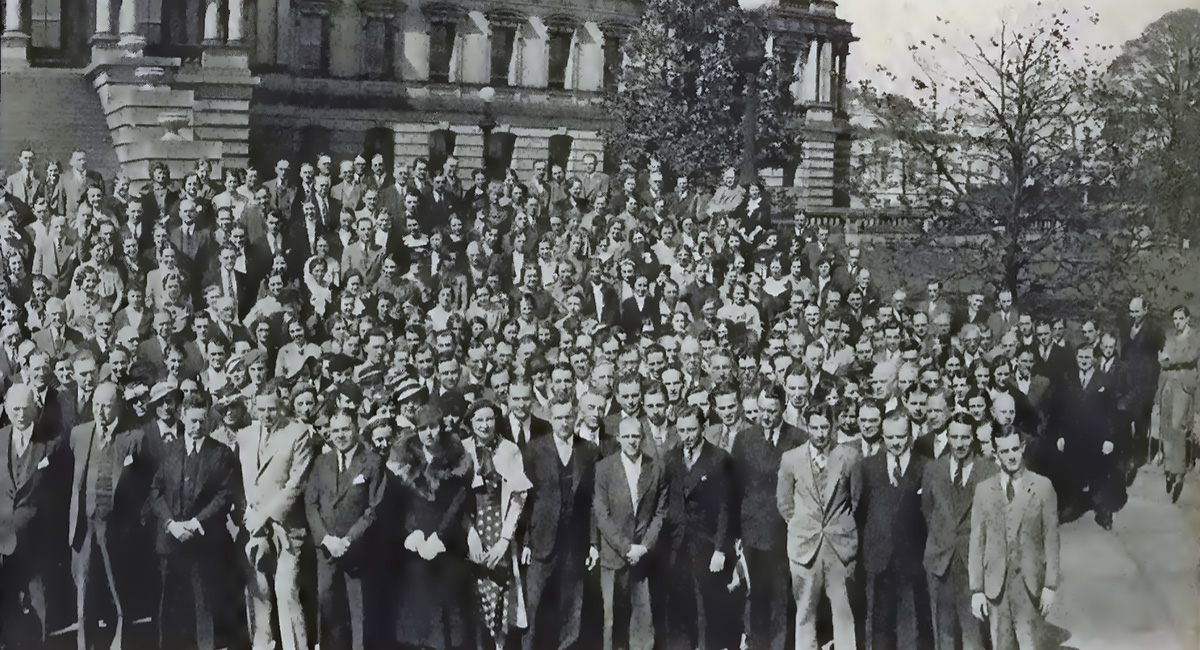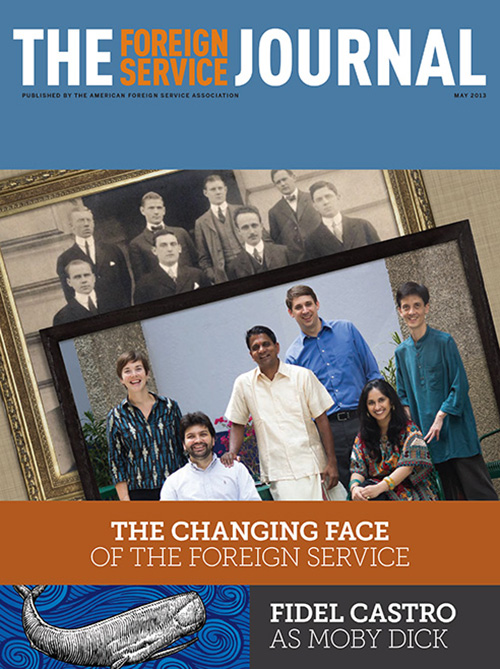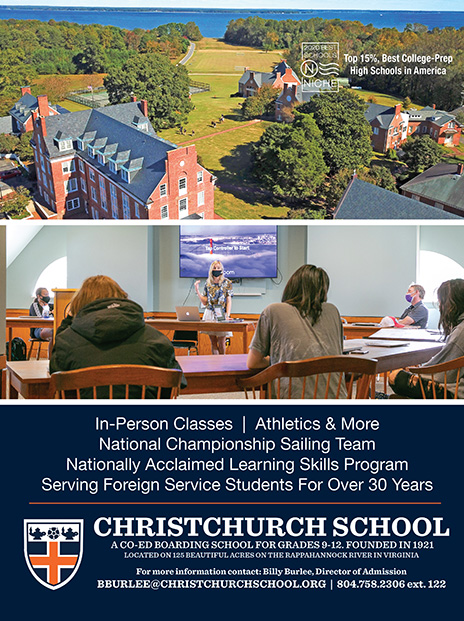Diversity and Inclusion in the U.S. Foreign Service: A Primer
Here is a historical look at gender, ethnic and racial diversity in the Foreign Service and the long and uneven battle for progress.
BY HARRY W. KOPP

Personnel of the Department of State in 1936—all white and overwhelmingly male.
AFSA / FSJ Supplement November 1936
In November 1936, The Foreign Service Journal published a photographic register of all 701 officers of the U.S. Foreign Service. Look at the faces: 700 white men and one white woman. Elsewhere in the Journal of that era, one could find an occasional racial slur. A 1937 appreciation of the late American minister to Finland praised his “rich repertory of Southern negro stories,” one of which the author gratuitously repeats.
Recounting these facts is not to single out the Foreign Service as particularly racist or sexist. Then as now, the Service reflected the values of American society at large, or more specifically of its leading institutions. Similar numbers prevailed in the Army and the Navy, in chambers of commerce, in state and local governments, schools and universities, indeed throughout most of civil society. The stereotypes that on rare occasions appeared in the Journal were, as Professor Henry Louis Gates Jr. has documented, pervasive across white American society, often in far more vicious form. In its social attitudes and behavior, the Foreign Service has always been a follower, not a leader.
The Foreign Service Act of 1946 included language to “insure … that the officers and employees of the Foreign Service are broadly representative of the American people.” The Congress that enacted that law had 11 white women and two Black men in a House of 435 members; in the Senate, every one of the 96 members was a white male. That Congress wasn’t bothered that the Foreign Service lacked women or minorities—its concern was a surfeit of Ivy Leaguers.
In its social attitudes and behavior, the Foreign Service has always been a follower, not a leader.
In 1940 about a third of the officer corps held degrees from Harvard, Yale, Princeton or Columbia. The Journal again: “Since Harvard is synonymous in many minds, however unjustly, with tea-drinking, peculiarities of speech and sartorial affectations, it is perhaps responsible for the persistent impression in certain areas of the United States that Foreign Service Officers are not as ‘American’ as they should be.” With regard to race, ethnicity and gender, neither Congress nor the Service could see its own blind spot.
In 1970 the corps of FSOs was still 95 percent male (2,945 of 3,084) and only 1 percent Black (34 of 3,084). All female FSOs were single and, until 1971, were required—apparently by administrative practice, not by law—to resign if they wed. Women and Black officers were restricted in where they could serve. Women were almost never sent to Islamic nations (lest they give offense) or to communist countries (lest they be sexually entrapped and blackmailed). Black officers were disproportionately assigned to Africa and parts of Latin America, a problem that persists today. A departmental task force in 1977 described the public view of the Service as “elitist, self-satisfied, a walled-in barony populated by smug white males, an old-boy system in which women and minorities cannot possibly hope to be treated with equity.”
Pressure groups began to form among aggrieved employees during the 1960s and 1970s. The Women’s Action Organization came together around 1970. Informal discussions among Black officers in foreign affairs agencies led to the formation of the Thursday Luncheon Group in 1973. These groups lent their support to two class-action suits filed in federal court. One, led by FSO Alison Palmer, charged the Department of State with discrimination against women in hiring, promotion and assignments; the other, led by FSO Walter Thomas, grew out of a finding by the Equal Employment Opportunity Commission (EEOC, chaired at the time by future Supreme Court justice Clarence Thomas) that the State Department “typically” discriminated against Black officers in assignments, performance evaluations and promotions.
The department fought these cases long and hard. The women’s case in one form or another ran on for more than 20 years, with the plaintiffs winning court orders that forced changes in department policies including, eventually, changes in the Foreign Service written exam. The Thomas case needed 10 years of litigation to produce a settlement awarding the plaintiffs retroactive pay and promotions. The presiding judge rebuked the department: “You shouldn’t be having an adversarial relationship with these people just because of their color. You should be … doing what’s right.”
| Foreign Service by Gender, Race and Ethnicity (round numbers) | |||||||
|---|---|---|---|---|---|---|---|
| Year | Total | Women (%) | African American (%) | Hispanic (%) | Asian (%) | Other (%) | |
| 1987 | FSO | 5,200 | 22 | 6 | 4 | 3 | No data |
| All FS | 9,400 | 24 | 5 | 3 | 2 | <0.5 | |
| 2005 | FSO | 6,300 | 37 | 5 | 5 | No data | 6 |
| All FS | 10,900 | 34 | 6 | 6 | 5 | 2 | |
| 2010 | FSO | 7,500 | 39 | 5 | 4 | No data | 7 |
| All FS | 12,700 | 35 | 6 | 6 | 6 | 3 | |
| 2015 | FSO | 8,300 | 40 | 5 | 6 | 7 | 6 |
| All FS | 13,500 | 35 | 7 | 7 | 6 | 4 | |
| 2020 | FSO | 8,000 | 42 | 6 | 7 | 7 | 6 |
| All FS | 13,700 | 37 | 8 | 8 | 7 | 7 | |
Sources: GAO, Department of State
Affirmative Action
These cases were still in the courts when Congress passed the Foreign Service Act of 1980, which governs the Service to this day. Like its 1946 predecessor, the 1980 act calls for a Foreign Service “representative of the American people.” But it also instructs the department to “pursue equal employment opportunity through affirmative action” and to manage its hiring, promotions and assignments “in accordance with merit principles.”
“Affirmative action” is a roomy phrase. When it is understood as measures against discrimination, it leads in one direction; but when it is understood as steps against inequality, it leads somewhere else entirely. With regard to the first, it is hard to dispute Chief Justice John Roberts, writing in 2007: “The way to stop discrimination on the basis of race is to stop discriminating on the basis of race.” But Justice Harry Blackmun, concerned with equality, had a powerful and opposite argument: “In order to get beyond racism,” he wrote in 1978, “we must first take account of race. There is no other way. And in order to treat some persons equally, we must treat them differently. We cannot … let the equal protection clause perpetuate racial superiority.”
Efforts to address inequalities by preferring members of some groups over others in hiring, promotions or assignments can leave those not preferred aggrieved. How, they ask, can personnel actions based on group characteristics accord with merit principles?
Tension between affirmative action and merit principles erupted in the 1990s, when budget and personnel cuts combined with rising numbers of political appointees to produce a shrinking Service with dwindling opportunities for promotion. In 1987, the Foreign Service numbered about 9,400 officers and specialists. By 1992 that number had fallen to 8,000, and by 1997 to around 7,000. Members of the Service, especially midrank officers, had reason to fear for their futures.
Tension between affirmative action and merit principles erupted in the 1990s.
These pressures made changing the demographic composition of the Service more difficult and resistance to change more intense. When several officers complained in the pages of the Journal about discrimination against white males, the Thursday Luncheon Group responded in a forceful August 1994 letter: Only 268 of nearly 4,000 officers are black, “fewer than 15 blacks have entered the Foreign Service since 1991,” white officers could not be threatened by these numbers, and “diversity and excellence are not mutually exclusive.”
A 1989 report by the General Accounting Office (now the Government Accountability Office) found the State Department short of EEOC targets for minorities and women in the federal workforce. In response, the department funded two academic fellowship programs, named for Career Ambassador Thomas Pickering and Congressman Charles Rangel, that provide financial support, mentoring, professional development and assistance for (primarily) minority-background students interested in a Foreign Service career. USAID launched a similar program, the Payne Fellowships, in 2012.
To improve diversity in the candidate pool, the State Department sent diplomats in residence—recruiters—to historically Black colleges and universities (HBCUs) and to Hispanic-serving institutions (HSIs) where a large proportion of the student body has a Latino background. After the turn of the century, the department modified its Foreign Service entry procedures in ways that increased chances for minority candidates to reach the oral assessment.
These efforts failed to produce the hoped-for results (see chart). Foreign Service hiring surged in 2001-2004 and again in 2009-2012, but minority hiring did not. Black officers were a smaller percentage of the officer corps in 2015 than in 1987. Hispanic and Asian American officers fared better, and women made significant gains.
During the recent hiring freeze (Jan. 23, 2017, to May 15, 2018), the department under congressional pressure brought on board about 60 Pickering and Rangel fellows, slightly increasing the share of minorities at the entry level. At the senior level, however, minorities fared poorly. Ambassador (ret.) Michael McKinley wrote in The Atlantic that “the most visible high-ranking Hispanic, African American, South Asian and female career officers were fired, pushed out or chose to leave during the first year of the Trump administration.” President Donald Trump appointed, and the Senate confirmed, 189 career and noncareer ambassadors: only five were Black.



The FSJ spotlights diversity issues. Shown above are covers from May 2013, June 2015 and October 2020.
GAO Report of 2020
Two generations have passed since the Service was described as a “walled-in barony populated by smug white males.” A GAO report in 2020, covering the period 2002 to 2018, showed uneven progress. According to the GAO:
• Over that period, the proportion of racial and ethnic minorities in the Service rose from 17 percent to 24 percent. In the Senior Foreign Service, minorities were 13 percent in 2002 and 14 percent in 2018. By contrast, in 2018 minorities were 21 percent of the entire Senior Executive Service.
• The proportion of women in the Foreign Service rose from 33 percent to 35 percent, and in the Senior Foreign Service from 25 percent to 32 percent. Women were 35 percent of the entire Senior Executive Service.
• Promotion rates for minorities were the same as for whites (except for promotion to FS-3, where the rate was higher for whites). Promotion rates were higher for women than for men. Attrition rates for reasons other than retirement or death were slightly lower for minorities than for whites, and equal for men and women.
• Racial and ethnic minorities in 2018 were roughly the same percentage of the Foreign Service as of all Americans classified by the Census Bureau as “professional workers” or “officials and managers.” Once again, employment trends in the Foreign Service were in line with trends in American society as a whole.
LGBTQ
Changes in American social values led to opening the Foreign Service to women and racial and ethnic minorities—but only after lawsuits and court orders forced the government to act. Changes in America’s social values were also the starting point for acceptance of employees regardless of their sexual orientation or gender identification. In this case, however, the department’s leadership was sympathetic to the cause, as were most members of the Foreign Service. Judicial intervention proved unnecessary.
As many commentators have observed, change in this area was relatively rapid. In the 1950s, generally accepted social values were virulently hostile to homosexuality, which was widely denounced as deviant, perverse and an offense against God. Senator Joseph McCarthy’s campaign to root out “subversives” stirred and elevated emotions that others exploited to launch a purge of suspected homosexuals. Their contention, rarely challenged, was that gays were vulnerable to blackmail and were therefore a security risk. “The constant pairing of ‘Communists and queers,’” wrote David Johnson in his book The Lavender Scare, “led many to see them as indistinguishable threats.”
By the turn of the millennium, conditions for LGBTQ employees had clearly improved.
In the 1950s and into the 1960s, State fired many hundreds of men suspected of being gay. Uncounted others quietly resigned rather than engage in a long and costly fight with an uncertain outcome and a high risk of exposure. Even into the 1980s, gay men and women at the State Department were routinely denied security clearances.
As the HIV/AIDS epidemic took hold in the United States in the 1980s, gay men and women across the country became more politically active. The organizing efforts of two State Department Foreign Service officers, David Buss and Bryan Dalton, led to the formation of Gays and Lesbians in Foreign Affairs Agencies (now known as glifaa) in 1992. According to the archived history on glifaa’s website, the group’s efforts “led to reform of the security clearance policy … as well as increased visibility of gay and lesbian issues in foreign affairs agencies.”
The Foreign Service Act of 1980, like the Civil Service Reform Act of 1978, required “fair and equitable treatment” for all employees and candidates “without regard to political affiliation, race, color, religion, national origin, sex, marital status, age or handicapping condition.” In 1994 Secretary of State Warren Christopher built on those provisions to prohibit discrimination in the State Department on the basis of sexual orientation. President Bill Clinton extended that protection to all federal civilian employees by executive order in 1998. Secretaries Madeleine Albright (1997-2001) and Hillary Clinton (2009-2013) extended to same-sex partners of State Department employees serving abroad the same benefits provided to opposite-sex partners, and Secretary Clinton took steps to prohibit discrimination against employees and job applicants on the basis of gender identity.
By the turn of the millennium, conditions for LGBTQ employees had clearly improved. Today, the nomination of gay men and women to positions requiring Senate confirmation attracts little notice.
A Special Moment
Diversity in the workforce can be quantified and measured, but inclusion cannot. Many minority members of the Foreign Service, even some with years of service and great professional achievements, feel undervalued and disrespected—not fully accepted and included. Some who came into the Service through the Pickering and Rangel fellowship programs conceal that fact, for fear that their colleagues will treat them as back-door entrants, not real FSOs—yet they have proved themselves twice, first just by getting into these highly competitive programs, then again by passing both the Foreign Service officer test and oral assessment, as all must do within five years.
Some with minority backgrounds have to contend with not-so-funny jokes based on stereotypes fashioned by whites. Women may be denigrated in subtle and unsubtle ways: “The department does not do a good job with issues like racism and sexual harassment,” said a female public diplomacy officer. “When it’s a senior guy doing the harassing, you don’t get treated fairly.”
There is widespread expectation that after the depredations of the past four years, the Biden administration will undertake a major rebuild at the Department of State. Proposals for reform have come from Harvard’s Belfer Center, the Council on Foreign Relations, the American Academy of Diplomacy, and any number of columnists and op-ed writers. Ambassador (ret.) Linda Thomas-Greenfield and Representative Joaquin Castro (D-Texas), among others, have called for new legislation to replace the 1980 Foreign Service Act, though without indicating what new authorities might be sought or requirements imposed. Every proposal addresses in some way the issues of diversity and inclusion. Surely the administration will need to take these questions on. In April, Secretary of State Antony Blinken appointed the first-ever chief diversity and inclusion officer, Ambassador (ret.) Gina Abercrombie-Winstanley.
In 2018, attrition rates for reasons other than retirement or death were slightly lower for minorities than for whites, and equal for men and women.
Shifting attitudes across American society have opened possibilities that did not exist before. Adam Serwer, a clear-eyed observer of racial politics, wrote in last October’s Atlantic: “There has never been an anti-racist majority in American history; there may be one today. … [I]n these moments, great strides toward the unfulfilled promises of the founding are possible.”
In the January/February 2021 Foreign Service Journal, the Association of Black American Ambassadors put forward specific recommendations for action to improve diversity, equity and inclusion at State and USAID, with an appeal for “clear and visible support from the highest levels.”
The president and the Secretary of State face excruciating demands on their time. Those who want to see broad changes in the Foreign Service are right to call for their support, but should not count on their sustained attention; reformers also need to consult and mobilize support from below. Without pressure from employees at all levels in the Department of State and other foreign affairs agencies, this moment, too, could slip away.
Read More...
- “From the FSJ Archive—Diversity in the Foreign Service,” The Foreign Service Journal, September 2020
- “Creating a Culture of Inclusion at State,” by Gina Abercrombie-Winstanley, The Foreign Service Journal, September 2020
- “State’s Problems Are Not New: A Look at the Record,” by Richard Figueroa, The Foreign Service Journal, October 2020





